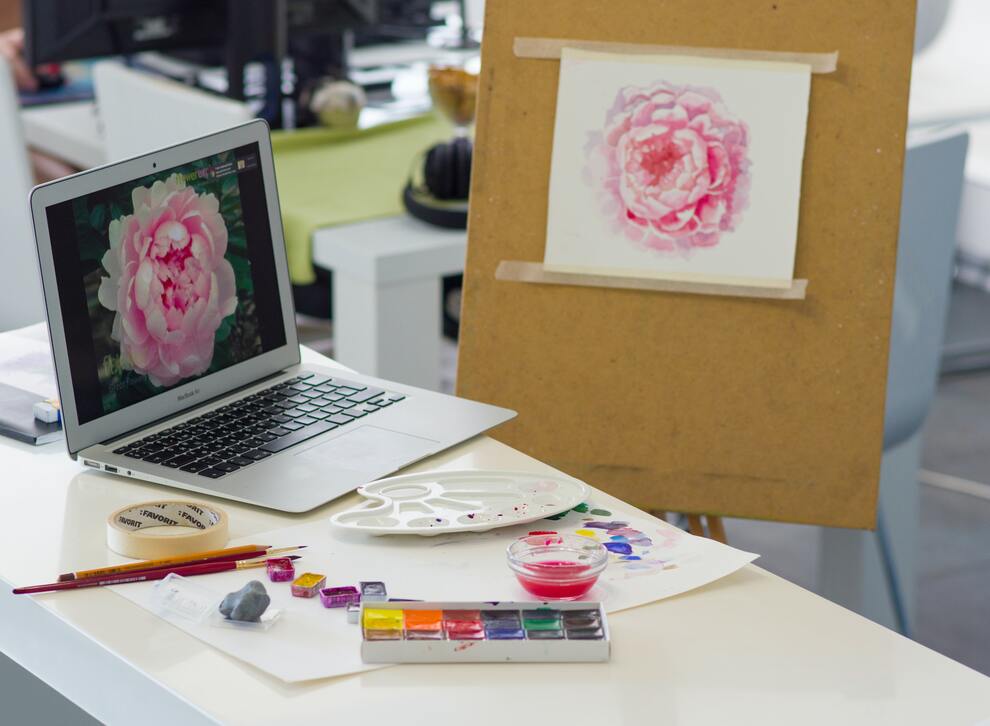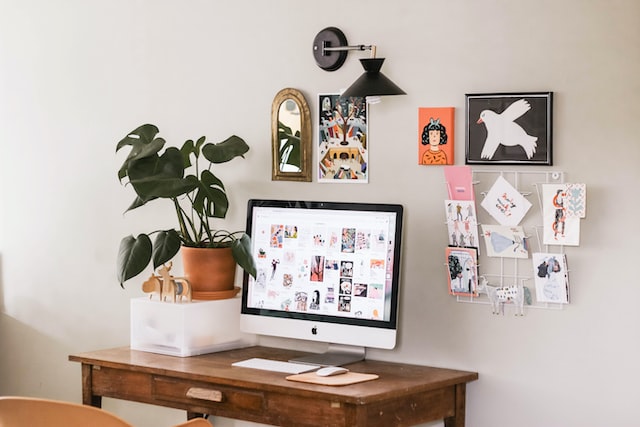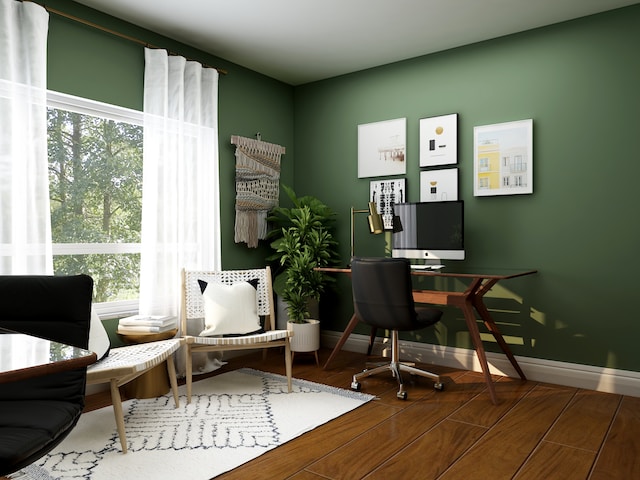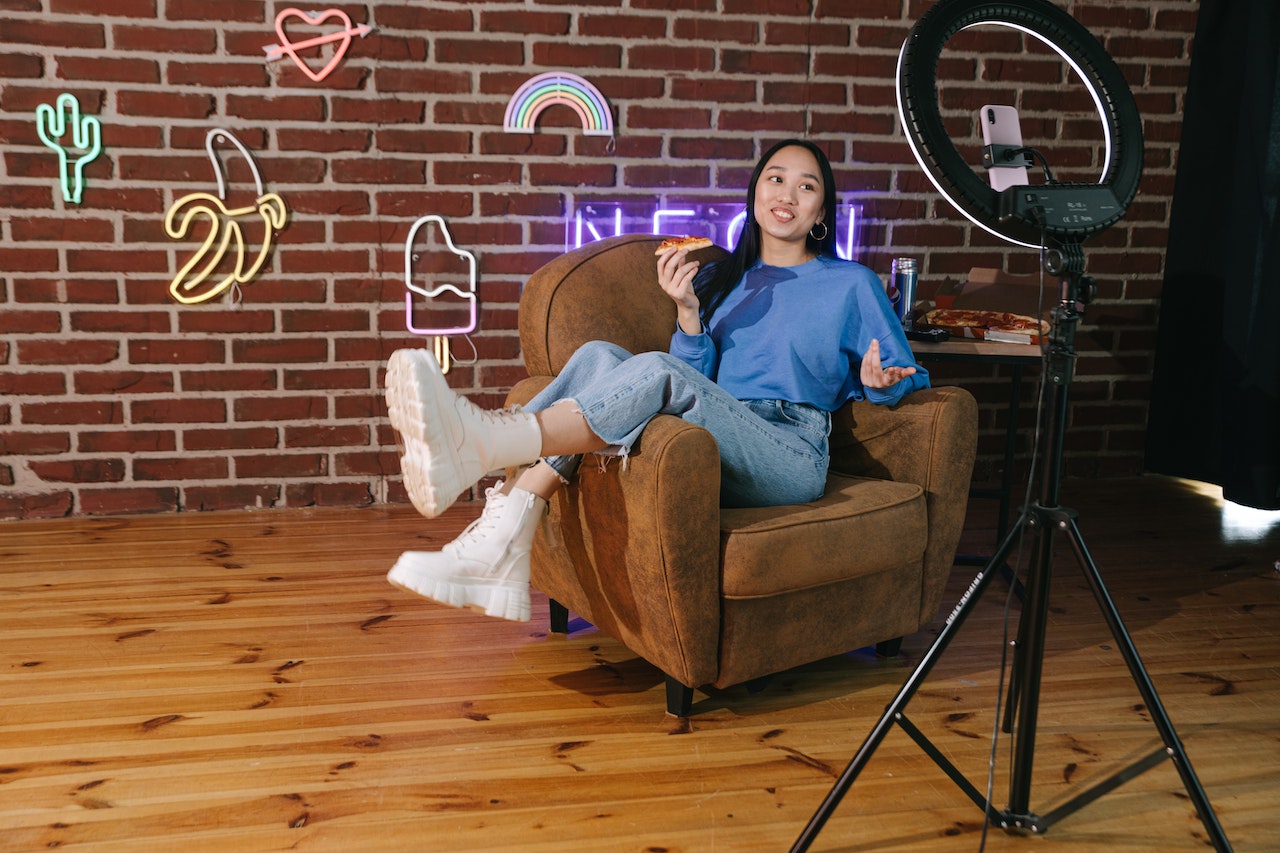Building an online presence is no longer unattainable. An abundance of user-friendly websites and social media platforms means that virtually anyone can set themselves up online — which is good, because establishing yourself as a professional artist is already tricky.
The onset of the digital age presents a new vehicle for marketing, as well as a new area of specialty: digital art.
Whether you want to market your traditional art, or venture into creating digital art, you’ll need to think about building your online presence.
Ways an online presence benefits your art
When you market your art locally, you reach a limited audience. By putting your art online, you open your audience to include millions of potential buyers. That increase is a strong argument for establishing a thriving presence online. Besides having a greater audience, you can also allow public comments — and these comments can absolutely provide constructive feedback for your art.
This kind of public engagement also helps you grow your following. People who follow you are more likely to buy from you and tell their friends about it because they appreciate the art you create and the parts of yourself you choose to share online.
A side benefit of creating an online presence is that it allows you to connect with other artists and exchange ideas. Social platforms — which you can use to cheaply market your work, if not market your work for free — are fertile grounds for inspiration. If you’re suffering from a creative block, combat it by choosing an image from social media and rendering it in your own style. The image doesn’t have to be interesting — sometimes the act of doing the work is all that’s needed to get your creative gears going.
How to start
Establishing your online brand can take you out of your comfort zone. After all, creating your brand is what sells your art, and what better way to keep your followers engaged than to continually break the boundaries of your own creativity? If you need a little help paying for internet while you get your business started, internet subsidies are available for low-income families.
In the midst of focusing on creativity and brand image, also consider the user experience on your website. A seamless and intuitive interface can make a world of difference for your visitors. The easier it is for potential buyers to navigate your portfolio, read about your journey, and make a purchase, the more likely they are to stay, explore, and invest in your art. Think of your website as an extension of your art studio; it should reflect your aesthetic while being welcoming and accessible. Remember, a positive online experience can significantly boost word-of-mouth referrals and repeat business.
You should not forget about the importance of website security. One of the key components of keeping your website safe for both you and your visitors is having an SSL certificate. If you run your page on WordPress, we would highly recommend using WP Force SSL plugin which will provide you with a free SSL certificate and many more features that will help you run your site without any coding background needed.
Between ensuring top-notch security and designing an eye-catching online space, it’s essential to optimize for user experience. Your website should not only be a reflection of your art but also an environment where visitors can navigate effortlessly. Loading times, mobile responsiveness, and easy-to-find contact details can make the difference between a one-time visitor and a returning admirer or buyer. Integrating features that foster interaction, such as comment sections, feedback forms, or even virtual galleries, can make your site more engaging. Prioritizing user experience means that every aspect of your site, from its aesthetics to its functionality, works in harmony to immerse the visitor in your artistic world.
Crafting a captivating online space to showcase your art shouldn’t be a daunting task. In this digital age, platforms like Visual Composer allow you to create your website without any coding experience. By utilizing such user-friendly resources, you can concentrate on designing a platform where your art takes center stage. This ensures your artwork captivates visitors and potential patrons seamlessly. Remember, in our interconnected world, a seamless and intuitive website can play a significant role in elevating your art’s online visibility.
Creating your online brand
Brands have identifying features that connect them to a company or a person. It’s what causes people to look at a thing and instantly know who made it. Developing a unique project name for your online brand can set you apart from the rest.
There are four ways to establish your brand
- Get personal.
- Study.
- Experiment.
- Finish it.
If you’re in the process of creating your online brand, think about getting some inspiration from other artists and creating a logo. For online marketing, especially if you want corporate buyers, having a well-planned logo is a smart decision. Ensure you are using a logo that is clear and easy to read. If your logo looks low-quality try using an AI image upscaler to improve the resolution.
Choosing the right channels
The beauty of online marketing is that you can build trust with your audience, which you find by choosing the right channels. A significant element of this process is uncovering the most effective ways to optimize your marketing efforts. It involves strategically selecting platforms, tailoring content to audience preferences, and analyzing engagement metrics to adjust tactics as needed. With thousands of websites and social media options to pick from, a little research can go a long way in ensuring your marketing resources are optimally allocated.
Ask yourself:
- Is it reputable? The website should be well-reviewed.
- How many artists are there? The website should have a large roster.
- How big is the audience? The website should have a large audience.
Online Galleries and Websites
With an established website or gallery, you have an established audience. All you need to do is register and upload your work.
Don’t use an obscure website — there, your work is just occupying space. Another mistake involves uploading your art to a low-quality site, which has the effect of lowering the value of your work.
You can create your own website. You are responsible for all the content, whether it’s visual art, videos, or a blog. If you choose to start a blog, you can use SEO to attract customers to your site. SEO uses keywords that are added to content to boost a website’s search engine ranking. With your website, you’re in control. If you aren’t fully versed on the topic, you can also hire an SEO consulting agency to help you get started.
Social media marketing
Social media has a huge audience, which you can direct to where you sell your work. But like any marketing channel, using social media has pros and cons.
Pros:
- Millions of users.
- Establishes brand recognition
- Free marketing
Cons:
- Frequent posting needed
- Potentially negative commentary
- Possible art theft
In spite of the cons, many artists exploit the potential of social media to reach millions of people. They do so by ensuring that they post consistently on all major platforms and create posts that interest their target audience. In order to do so, a social media scheduler can help. It helps to schedule schedule Facebook posts, Instagram posts, tweets, LinkedIn posts, and more.
Optimizing your channels
Optimizing your channels involves following a set of best practices. These typically apply to websites for SEO optimization, but they translate to social media as well. There are different content marketing techniques that will help you improve your online presence. The most important thing to remember is to take it slow and enjoy the process of gaining followers. If you try to do too much too fast, you might get overwhelmed and the creative work you once loved could become a burden.
Content calendars
In audience engagement, content is key. It can be a blog post, a status, or an image. Creating a content calendar can simplify the process. Your calendar should include dates, your channels, and what you would like to post about. Creating your calendar and social media posting schedule ahead of time allows you to create posts that are unique, relevant and engaging.
Tools to help you build your online presence
Representation is part of creating your online brand, so you might want to invest in some basic equipment. The easiest way to represent your work online is to photograph it. Your photos need to be clear, and they should be able to be reduced without sacrificing quality. A decent digital camera is your best option — once you have a quality camera in hand, you can ensure you take good, clear images of your work.
You’ll also need high speed internet, a computer, and photo-processing software like Adobe Photoshop, Corel Paintshop Pro, Picuki or GIMP. There are different free image editing online tools that can help you in this task. Your camera can create videos for you, since they come with a video setting. Here’s a tip, though: buy a separate microphone. Your camera’s built-in microphone isn’t directional, so it’ll pick up unwanted background noise.
If you’re having trouble finding quality internet in your are, check out the internet specialists available near you to help you install fast internet. You can also find a great selection of internet packages that allow you to compare, customize the right internet package for you and your family.
Feel free to set up accounts with more than one platform so you can expand your marketing
Tips for different art styles
In the online world, having a following can get you the kind of exposure you need to get noticed by the right people.
For musicians, that might mean uploading photos and videos of your performances. These don’t have to include you performing at public venues — the comfortable atmosphere of a homemade video can have the benefit of making you seem more approachable to potential fans. If you need to compress your videos, here is the best guide on how to compress mp4 video.
Actors and filmmakers typically also require a work portfolio, which you can have in an official capacity on an agency website or promote yourself via social media platforms like TikTok or Instagram. If you haven’t been able to find work the traditional way, you can collaborate with other artists to create short films or series online. Photographers will also find that showcasing their work on social media can help them expose their work and expand their following.
Blogs are especially valuable for writers. Publishers want to know that their chosen writers come with a list of previous work and a following that can boost the publisher’s book sales. Blogs offer unlimited subject potential, which writers can exploit to gain an audience and take advantage of the writing tools available. The writer can use their blog to post their thoughts, publish stories online, offer teasers for future novels, and garner public engagement. Writers may also take advantage of email marketing by creating a mailing list to send new publications.
No matter the art form, there are substantial benefits to creating an online presence. The digital world offers the potential to grow your audience by leaps and bounds if you market yourself using the right platforms for your specific type of art.
Make money online as an artist
The most obvious way to make money is to simply sell your work in online galleries, but you can take that a step further. Certain sites allow artists to upload and sell their images by creating a profile and offering their art through different products. You can stay true to the original format of your work, but you can also earn money by selling your work as mugs, t-shirts, cards — anything you can put a picture on.
Something else to consider is selling your images as stock artwork. Selling them as stock allows your potential audience a set download limit, for a price. Photography websites provide a convenient platform for artists wishing to earn money through the sale of stock art.
However, when conducting business online, it is crucial to stay GDPR-compliant. The General Data Protection Regulation (GDPR) is a regulation in EU law that protects the privacy and personal data of EU citizens. As you’re dealing with customers from all over the world, ensure that you’re meeting the GDPR requirements when handling customer data, especially when selling to European customers.
If you’re not shy about sharing your process, you could create how-to videos so that your audience can reproduce your art for themselves. You could use your own website to host these videos, but by uploading them onto a public video-sharing website like YouTube, you can make use of that website’s existing audience.
No matter how you choose to get yourself online, your success will be due largely to marketing. The simplest way to market yourself is through social media, where you can post your art and your process while growing your online audience. There are even music platforms that allow you to upload your music so people can listen to the music you create. When making social media posts — whether it’s on a video-sharing website or a music platform — you can link to your website or wherever your art is sold online.
Digital art
Technically, “digital art” can refer to anything from clip art to complex or vector images. Using technology to create and present artwork can offer an artist a larger audience beyond traditional art buyers.
There are many types of digital art, including the following:
- Vector painting – Made using the vector storage format.
- Raster painting – Made using the raster storage format.
- Pixel art – Art created at the pixel level.
- Photo painting – Manipulating an original photo.

NFTs
An NFT (Non-Fungible Token) is a digital item that can be bought and sold online. NFTs are often coded using the same type of software as many cryptocurrencies. The difference between NFTs and cryptocurrencies is that cryptocurrencies are “fungible,” meaning they’re created in large or infinite amounts. NFTs are typically one-offs, making them rare and thus increasing their worth. NFTs aid in creating online fame and wealth for artists, by allowing them to register their work on a blockchain, which is a sort of ledger that tracks the sale of cryptocurrencies and NFTs.
NFTs got their start as “colored coins,” a Bitcoin digital token that represented assets in the real world — assets like collectibles, company shares, coupons, and more. From there, NFTs grew to include digital art that could be created and sold for substantial amounts.
Individual buyers are an obvious market, but corporate buyers are fast becoming a top contender for this kind of digital art. In fact, many corporate buyers are just waiting for an artist like yourself to mint — that is, create and publish — the right NFT for their needs.
Start building an online presence and give your art the attention it deserves. There are plenty of easy steps you can take to get your art noticed and begin gaining a following of people who love to see the art you create — and even pay for it. No matter what type of art you make, you’re sure to find a group of like-minded people from all over the world who appreciate it just as much as you do.




